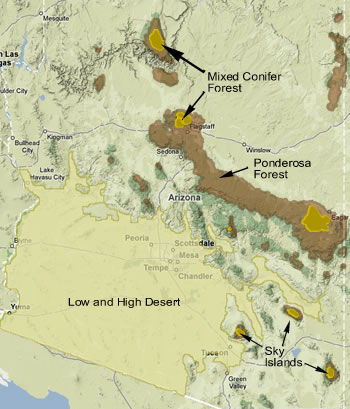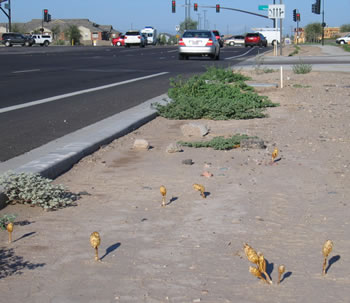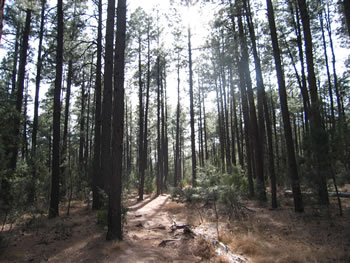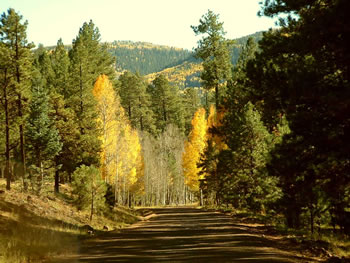Introduction
Major mushroom environments in Arizona
Arizona contains a wide variety of ecologically distinct zones. Nearly every major North American biome is present here. Typically, about 15 distinct biome types are recognized in Arizona, but I have seen over 20 listed in other articles. For our sake, we will only consider three major Arizona biomes:
- The urbanized desert
- Ponderosa forests
- Mixed conifer (including sub alpine) forests
As a general rule, the greatest variety of mushrooms can be found at high elevations in Arizona. But I'm sure you already knew that.
Notes:
Not mentioned in this section are mushrooms found within the high desert and pinyon-juniper forests. This environment is defined by the presence of pinyon pine and juniper, in combination with transition zones with agave, ocotillo, and various shrubs. Low desert mushrooms can also be found here, in conjunction with a much larger variety of stalked puffballs and earthstars. Because none of these are edible and are rarely the targets of a foray, I left the high desert and P-J forest out of this section.
It is also worth mentioning that desert riparian areas provide a moisture rich habitat that will contain very different mycoflora than the surrounding desert. Riparian habitats also are not covered.
 Figure 1: The three biomes covered in this section.
Figure 1: The three biomes covered in this section.
- Urbanized desert
In general, the desert is not a very good place to go looking for mushrooms. However, in urban environments, we have created better environments for fungi through landscaping. As the majority of Arizona's population lives in the urban desert, I felt it was a good idea to cover some of the more common mushrooms found there. Please note that no edible mushrooms appear in the urbanized desert, so this section is mostly to aid in recognizing these city slicker mycoflora.
 The urban desert
The urban desert
- Ponderosa forest
Arizona forests are primarily arid forests that come in two colors: the Pinyon Pine and Juniper forests of the high desert; and Ponderosa monocultures at higher elevations. Both of these areas experience limited rainfall and tend to have sandy soil with a thin (if any) humus layer. In the P-J forests, the only mushrooms you can expect to find are xeritolerant stalked puffballs and some wood rotting bracket fungi.
Ponderosa forests recieve a bit more precipitation and have a bit deeper humus layer, so host a greater variety of mushroom producing fungi. Among these are several edibles, but the variety is limited and distribution can be sparse. Still, Ponderosa forest is accessable to the vast majority of Arizonans, so is certainly worth considering for a casual foray.
The best locations to visit in Ponderosa forest are obviously those which recieve the greatest rainfall. These areas are typically on the top of the Mogollon Rim, closest to the rim edge. At these locations, the abrupt rise in elevation causes air to cool and precipitate. These moist zones usually only reach about 5-10 miles northward from the rim edge.
 Ponderosa forest
Ponderosa forest - Mixed conifer forest
Mixed conifer forests occupy a minority of Arizona forest area, but as far as mushroom hunting goes, they are where all the action is. These forests occur at high elevation, typically greater than 7000', and get the most amount of precipitation in the state. Their thick humus layer retains moisture, and their thick canopies reduce evaporation. These areas host a mixture of Ponderosa Pine, Douglas Fir, and scattered Aspen groves. At the highest elevations, other firs and spruces will occur.
The primary locations of mixed conifer forests in Arizona are the White Mountains and the Chiracauas on the New Mexico border, the San Francisco Peaks in Flagstaff, and scattered sky islands in the Tucson area. For the Arizona mushroom hunter, there is a tradeoff between accessability and desireability.

Mixed conifer forest
Photo: Michael Weberg
Notes on the mushroom lists
As should be obvious, there are far more mushroom producing species in Arizona than can be covered here. I have selected the species / groups in the following sections based mostly on the frequency that I have encountered them (excluding the numerous uninteresting LBMs). Of course, the tasty and the showy ones recieved extra weight in the selection process!
The information contained in each description will not contain the detail you would find in a field guide. This is intentional, as you won't have my website with you out in the field. My goal is to familiarize you with what is out there more than anything else; to facilitate your appreciation of our wonderful mycoflora.
I strongly recommend that you visit the Arizona Mycota Project website to get a feel of what is really out there. The AMP maintains species lists that are updated annually based on the results of organized forays by the Arizona Mushroom Club and individual submissions. I believe the current number of known mushroom producing fungal species in Arizona is around 1300.